Light show on public rubbish bins applaud your discarded face mask

A student team form the Eindhoven University of Technology in the Netherlands is designing an interactive rubbish bin that encourages people to dispose of their litter properly.
Litter places a heavy burden on the environment. It is a persistent problem. At the moment there is even more litter floating about thanks to face masks that have been dumped all over the street. In order to make people aware of the problem and to teach them not to throw their trash on the street, an Eindhoven student team is developing the BrightBin.
Holle Bolle Gijs – the paper gobbler
The add-on makes an average rubbish bin on the street interactive and offers people a small reward if they throw something into it. For example, they get a round of applause. A kind of Holle Bolle Gijs ( the paper gobbler), like at the Dutch amusement park De Efteling, as described in an earlier article. BrightBin is part of Enactus, a worldwide student organization that promotes social entrepreneurship.
Last year the BrightBin was located along the same route as the Eindhoven light art festival Glow, which attracted 750,000 visitors. As a test, to see if the idea could work, says Andriesse. The light effect drew people to the rubbish bin, the student recalls. That effect was what is called an ‘infinity mirror,’ a LED strip between two mirrors. People saw their reflection and the lights were endlessly flickering on and off, Andriesse explains. “And when they realized that they were receiving applause whenever they threw something into it, they kept that up. Groups gathered around the BrightBin because people really liked it.”
Realistic streetscape
“People expect to see fantastic light shows during Glow and to be surprised. That’s why it was great to see that the rubbish bin had such an effect, but it’s not a realistic streetscape,” Andriesse adds. Andriesse learned during the accelerator program that the student team followed last year through Enactus that “you have to make your product relevant.”
Andriesse goes on to say that you can do this by, among other things, making sure that there is a focus. “The broader the market, the more difficult it becomes for you to find a party who is really interested in the BrightBin. That’s why the focus is now on municipalities and cleaning companies. “These organizations can put the BrightBin on rubbish bins where it has the most impact: on the street.”
Resale
The students had thought last year that they were going to bring the product onto the market themselves. “Growing into a stand-alone start-up and hopefully a profitable company, but always with the idea in mind that we are doing something good for the world,” said one of the members at the time. That idea has changed. Andriesse: “Our main goal now is to develop a ready-made concept. A technical blueprint of our product together with a tested and working prototype. We could sell that on to a cleaning company, for instance. That way we can make a better and simpler impact with our product.”
That prototype still needs some development, says Andriesse. A working interactive device on the street has to be able to take a beating. During Glow, the students kept an eye on their bin attraction. “But what we really want is for this kind of rubbish bin to be on the street permanently, without any supervision. With an energy source that lasts a long time. And a rubbish bin like that has to be idiot-proof.”
Crowdfunding
Last summer the students raised €1,200 from crowdfunding. A good start for making a new prototype out of high-quality materials, says Andriesse. That prototype will be made at Innovation Space, the place at the Eindhoven University of Technology (TU/e) where student teams can build and test prototypes.
The team will also receive guidance from the technical staff at Innovation Space’s workplace. External experts are helping with the choice of materials. And with support on finance and marketing, since this crowdfunding is really a solid start, Andriesse notes, “But more is needed if we really want to be able to build the prototype.”
Andriesse expects to have a tested prototype ready by June next year. The students are now looking into which materials are suitable and what the interactive part will look like. “Once we’ve built that first prototype, we hope to be able to find parties more easily who are willing to make an investment in order to be able to build it.”
Testing on the street
From organizations such as the municipality of Eindhoven and the CSU cleaning company, the team was told that it was still too early for them to start working with it in concrete terms, says Andriesse. “They want to see a tangible prototype that has been proven to work. We were previously given permission by the municipality of Eindhoven to test our prototypes on the street. We hope that we will get that again with our new prototype.”
During the presentation on October 1 of the Techrede, an initiative from the 4TU Federation, the ‘Glow prototype’ of the BrightBin stood between innovations from the four Dutch technical universities. “This meant that we were able to demonstrate our product, while others talked about what our future will look like in thirty years’ time. The perfect podium.”